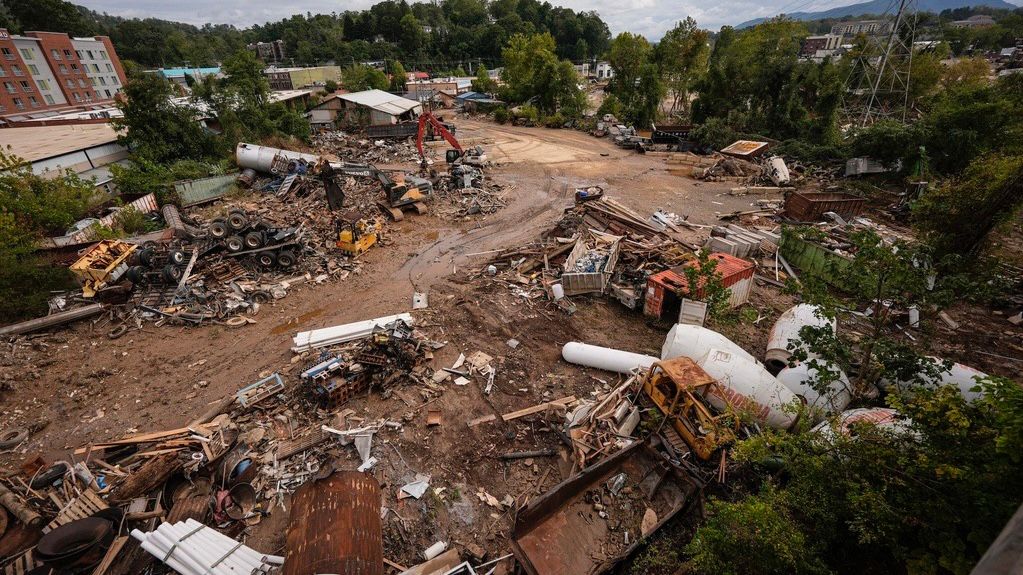As the death toll from Hurricane Helene passes 160, the Federal Emergency Management Agency is responding with resources from multiple government departments.
FEMA has so far sent 3,500 personnel to support a complex recovery in the four states that have been declared emergencies, including 1,250 urban search and rescue personnel and 150 ambulances. The Department of Health and Human Services has also dispatched a portable morgue to North Carolina.
“While response efforts are underway, we know many families are grieving and suffering. This is a widespread and, in many cases, historic disaster,” FEMA Individual Assistance Director Frank Matranga said during a briefing Tuesday. “For survivors out there, we want them to know they are not alone and we’ll be there to help them for as long as they need.”
Since Thursday, when Hurricane Helene made landfall, 17 counties in Florida, 11 counties in Georgia, 13 counties in South Carolina and 25 counties in North Carolina have been declared emergencies eligible for disaster relief and emergency assistance. Hurricane Helene is one of the deadliest and costliest storms to ever hit the United States.
More than 150,000 households have so far registered for assistance through the FEMA — a number the agency expects “to rapidly increase over the coming days,” Matranga said.
FEMA is encouraging all affected survivors to register for assistance in person at a disaster recovery center, online at disasterassistance.gov or by calling 800-621-3362.
Hurricane Helene’s death toll is expected to rise, since much of the storm impacted remote, inland areas that emergency teams have yet to reach. The American Red Cross said Tuesday it has fielded more than 3,000 calls in the last 24 hours from people searching for missing loved ones.
More than 40 of the 135 people reported dead from the hurricane so far were in North Carolina, where the storm triggered flooding and mudslides. FEMA said Tuesday it is sending a portable morgue to the area – the first time it has done so since 2023, following the wildfire in Maui, Hawaii, that killed 100 people.
“It should be a signal that we’re concerned about fatality management and making sure state and local coroners have the things they need,” Health and Human Services Deputy Assistant Secretary Jon Greene said. “It is not a signal of a large-scale fatality event. It’s just a prudent precaution.”
The Department of Health and Human Services set up a patient care location in Asheville, N.C. Monday and is setting up a second location in Spruce Pine, N.C. — an area that experienced catastrophic flooding. Greene said additional disaster medical assistance teams are currently being staged in Charlotte, N.C., and will be assigned to locations directed by the state.
More HHS disaster medical assistance teams will arrive in Atlanta, Ga., on Wednesday.
FEMA’s urban search and rescue division has dispatched more than 50 teams to operations across five states, including Florida, North Carolina, Tennessee and South Carolina. The teams are working to cover 600 square miles it says were severely affected by flooding and mud slides that resulted in debilitating infrastructure damage.
The American Red Cross said it has launched a massive response along the 500-mile path of destruction. As of Monday morning, its national sheltering system had identified more than 2,400 disaster survivors using 75 shelters. Red Cross spokesperson Denise Eberhardt said the shelters experienced a 9% decrease in usage overnight except for North Carolina, where usage has increased.
The Red Cross has more than 1,000 responders on the ground and another 250 traveling into the affected areas Tuesday. It said it’s recruiting another 400 responders across the country to travel to the area over the next few days.
The Environmental Protection Agency said it is working with federal, state, local and tribal partners to assess damage to drinking and wastewater systems to get them back online as soon as possible. The agency is also working to remove hazardous materials and to safely manage debris, Martha Guzman, the acting Deputy Secretary for Region 4, said.
The U.S. Department of Agriculture estimates agricultural losses of at least $7 billion, USDA Under Secretary for Farm Production and Conservation, Robert Bonnie, said Tuesday. The impacts to the area’s agriculture and forestry are “significant” with impacts that will potentially last years.
Cotton production in Georgia, citrus groves in Florida, as well as corn, soybean and pecan fields, are the most affected crops covered by USDA crop insurance.
Bonnie noted that poultry has experienced significant impacts, along with timber.
“There’s a lot of timber on the ground,” Bonnie said, adding that the USDA does not insure the timber industry. “The challenge with a storm like this is it’s hard to market the timber. There’s significant losses. We’ve reached out to the forest industry to assess losses.”



